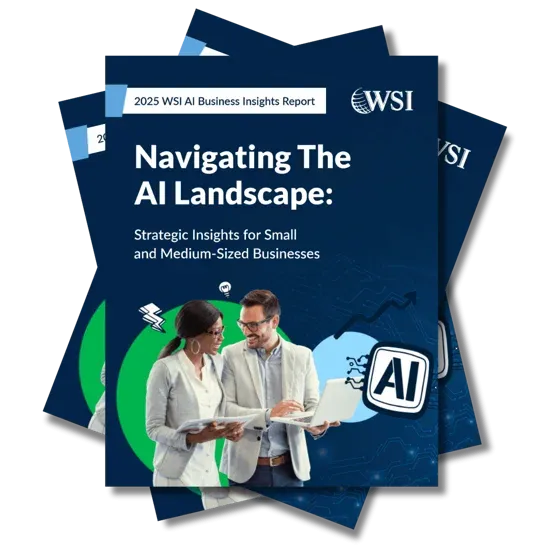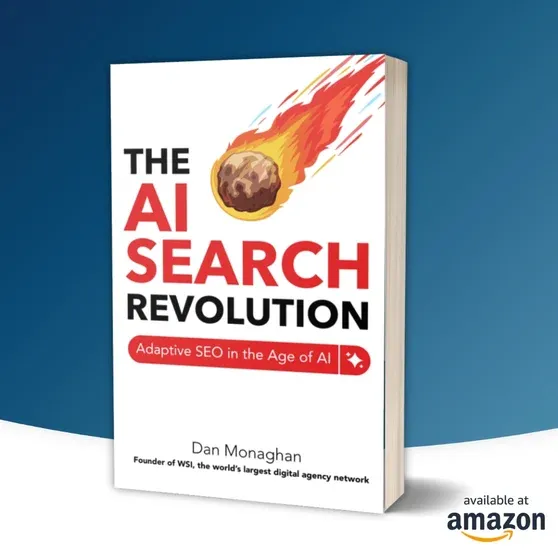Bridging the AI Gap: From Planning to Strategic Implementation

Summary: WSI’s AI Business Insights Report 2025 shows that businesses are planning to implement AI solutions, but they have not yet aligned their strategies with those plans. More than 80% of companies say AI is on their roadmap, but fewer than 30% have a plan to make it real. The gap between AI intent and strategy is now one of the most significant barriers to growth in 2025.
Here’s what you will learn:
- Our latest AI Business Report reveals a breakthrough insight: businesses are planning for AI but not strategizing their implementation.
- Why is a strategy essential for successful AI implementation?
- How can your business step up from planning to strategizing?
Over the past few months, we have been sharing insights and takeaways from our latest AI Business Insights Report. This report assesses the extent to which AI is being adopted by businesses, both large and small, across all sectors.
The report reveals three key insights:
- Confidence in AI is growing, but action plans and budgets have not kept pace.
- Businesses and their staff are more familiar with AI, but formal training still lags.
- AI adoption is spreading beyond company leadership into other departments and levels, but widespread adoption is still not happening.
In addition to these takeaways, several breakthrough insights will help us all understand the current state of AI adoption and take action to speed it up:
- Businesses are planning for AI—but their strategy is still catching up.
- Leaders are excited about AI—but middle managers are doing the heavy lifting.
- AI adoption rates show significant industry-specific differences, with some sectors demonstrating advanced integration while others have yet to begin.
- AI is reshaping jobs; the impact depends on the industry in question.
- AI is not a solo sport: external partners are important to move adoption along.
Let’s focus on the first breakthrough insight: businesses are planning for AI, but their strategies are still catching up.
Breakthrough Insight: More Businesses Are Planning for AI—But Strategy is Still Catching Up
In 2024, our survey revealed that 55% of businesses had either not discussed AI formally or had only held informal conversations about it. The 2025 data show encouraging progress: that number has dropped to 37%, indicating that more organizations are beginning to incorporate AI into structured planning conversations.

And yet, planning doesn’t always equal action. Budget allocation has only slightly improved, and just 27% say AI is regularly discussed across the company. These numbers signal that while AI is starting to show up in boardrooms, it hasn’t fully landed in business plans.
What we’re seeing is the early formation of strategy—a shift from “should we?” to “how might we?” It’s a positive signal of intent, but businesses still need structured guidance and planning tools (like WSI’s AI Adoption Roadmap), as well as internal alignment to turn that intent into measurable outcomes.
From Planning to Action: How to Bring Strategy in Line with Your AI Plans
Many businesses, perhaps yours included, have already discussed where AI might fit into their operations. You’ve read the reports, explored tools like ChatGPT or Jasper, and even asked your team to “see what AI can do.” But as WSI’s AI Business Insights Report highlights, that’s where many companies stop: the discussion phase.
Turning plans into real-world outcomes requires strategy, structure, and alignment. It’s not just about identifying what AI could do — it’s about defining how AI will support your business goals, team capacity, and long-term growth.
For business leaders, this means ensuring that every AI initiative directly connects to revenue, efficiency, or customer experience. It’s about building processes, training teams, and measuring outcomes across campaigns.
So, how can businesses move from exploration to execution?
1. Define Clear Business Objectives Before Choosing AI Tools
One of the most common mistakes—beyond not getting started with AI at all—is starting with tools instead of goals. It’s an easy trap to fall into: get caught up in the excitement of new technologies without stopping to think about what you should actually use them for. Without defined objectives, these tools often fail to deliver measurable results.
Start by asking:
- What specific business problem are we solving with AI?
- How will we measure success (e.g., reduced customer churn, faster lead response, improved personalization)?
- What data do we need to achieve it?
Once objectives are clear, the technology can be chosen to support them—not the other way around.
2. Build a Cross-Functional AI Task Force
AI adoption isn’t an IT project—it’s an organizational evolution. Successful businesses create cross-functional teams that bring together leadership, marketing, operations, sales, and data analysts.
For business leaders, this ensures the investment in AI delivers tangible business value and avoids siloed spending. Best of all, it also fosters collaboration and ensures that marketing data aligns with other business systems, such as CRM and customer support.
Establish regular check-ins to discuss progress, challenges, and new opportunities. This cross-functional approach turns AI from a technical experiment into a company-wide initiative.
3. Align Budget and Resources with AI Ambitions
Our report shows that while planning for AI is increasing, budgets have not kept pace. Without proper funding, even the best strategy can stall.
A practical approach is to start small, measure fast, and scale strategically.
- Begin with one or two high-impact pilot projects, such as automating lead qualification or using predictive analytics to refine ad targeting.
- Assign clear KPIs and evaluate ROI within a defined timeline.
- If the results are positive, scale the initiative and reinvest accordingly.
This ensures your AI journey remains manageable, measurable, and tied directly to business growth.
Processes: Integrate AI into Everyday Operations
AI works best when it’s embedded into existing workflows—not treated as a side project. That means:
- Automate routine processes like reporting, lead scoring, or customer segmentation.
- Use AI-powered dashboards to track campaign performance or sales trends.
- Implement feedback loops that refine AI recommendations over time.
Integrating AI into daily operations allows for seamless adoption rather than forced implementation.
Building the Foundation: Data, People, and Processes
AI success depends on three interconnected foundations—data quality, human capability, and process integration. Neglecting any one of them can limit the value of your AI initiatives.
Data: From Collection to Connection
AI thrives on clean, connected data. Unfortunately, many businesses still operate with siloed systems where marketing, sales, and customer data don’t align.
- Consolidate your data sources with an integrated CRM such as HubSpot, VBOUT, or SharpSpring.
- Establish data hygiene practices to ensure accuracy and consistency.
- Use AI tools to identify gaps or anomalies in customer journeys.
When data flows freely across your organization, your AI systems can make faster, smarter, and more personalized predictions.
People: Equip Teams with AI Literacy
AI isn’t replacing people—it’s amplifying their potential. But this can only happen if your teams understand how to use it.
- Provide formal training sessions on AI tools your teams already use (e.g., Google Ads AI, ChatGPT, or HubSpot’s AI features).
- Encourage a “test and learn” culture — where experimentation with AI is supported and shared.
- Create internal champions or “AI Ambassadors” who help others adopt tools confidently.
This means upskilling their marketing team to optimize AI-driven workflows, ensuring their investment in AI pays off through improved productivity and innovation.
👉 Want to see how AI could work across every department in your business? Our AI Consultants can map out opportunities tailored to your operations.
Overcoming Common Roadblocks
Even with a solid plan, businesses often face challenges when transitioning from planning to execution. There can often be a lack of internal alignment. Teams may have different views on what AI should accomplish. Establish clear communication channels and a unified roadmap to ensure alignment from leadership to execution.

Without training, teams may underuse or misapply AI tools. Invest in education and support, and consider partnering with an experienced digital agency like WSI to accelerate adoption. Finally, when early results aren’t tracked, AI investments can seem abstract. Define metrics upfront and communicate wins regularly to build momentum.
Partnering for Success: Why AI Isn’t a Solo Sport
As our report confirms, AI adoption accelerates when businesses work with external partners. Agencies like WSI bring the expertise, frameworks, and tools to help companies like yours move from exploration to full integration. For business leaders, this partnership will ensure that investments deliver tangible results with minimal risk while providing access to expert-led strategy, training, and implementation support.
With our support, you can shorten the learning curve and make AI part of your company’s competitive advantage.
The Future of AI Strategy: Adaptive, Measurable, and Human
AI will continue to evolve rapidly, but one thing won’t change: successful adoption will always depend on strategy, alignment, and human insight.
As predictive systems and automation advance, the most successful businesses will be those that:
- Keep their strategy flexible and responsive.
- Use AI to enhance — not replace — human decision-making.
- Measure outcomes rigorously and continuously refine processes.
Business leaders can enjoy sustainable, data-driven growth, while innovating confidently within a clear framework.
Turn AI Intent into Impact
AI has the potential to transform your business — but only if you move from planning to doing. Strategy is the bridge between ideas and impact.
At WSI, we help business leaders and marketing teams design and implement AI strategies that drive measurable results — not just more conversations.
Ready to turn your AI plans into performance? Book a free consultation with WSI today and discover how to build a smarter, more strategic AI roadmap for your business.
| AI Strategy and Adoption FAQs Q: Why do most AI initiatives fail to move beyond planning? A: Many businesses jump into AI without aligning technology with their core goals. Without clear objectives, budgets, and leadership support, initiatives stall before generating measurable ROI. Q: What’s the difference between AI planning and AI strategy? A: Planning defines what you want to achieve with AI. Strategy defines how you’ll do it — setting goals, aligning teams, securing data, and assigning budgets to ensure sustainable results. Q: How can small and mid-sized businesses like mine afford AI? A: AI tools are now accessible and scalable. Start with one high-impact pilot project—like automating lead qualification or content creation—then reinvest based on early ROI. Q: How do I measure the success of AI in my marketing or operations? A: Track business outcomes, not activity. Key metrics include cost savings, lead-to-sale conversion rates, customer satisfaction, and marketing ROI per AI initiative. Q: Should we manage AI adoption in-house or partner with experts? A: For most SMBs, a hybrid model works best. Internal teams handle execution while AI strategy partners like WSI provide frameworks, training, and integration support to ensure measurable results. |
About the Author
Rick spent 20 years in the insurance industry in finance, primarily developing reporting platforms for B & C stakeholders. His ability to speak to consumers of data (managers and analysts) and translate their needs to programmers led him to start his own digital marketing agency in 2004 to develop data driven solutions for business owners.
The Best Digital Marketing Insight and Advice
We are committed to protecting your privacy. For more info, please review our Privacy and Cookie Policies. You may unsubscribe at any time.
Don’t stop the learning now!



